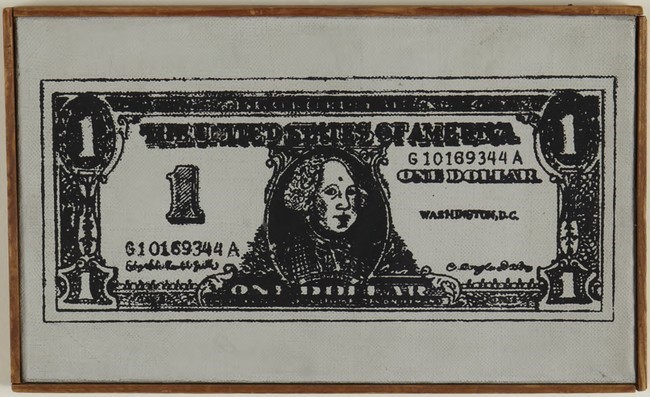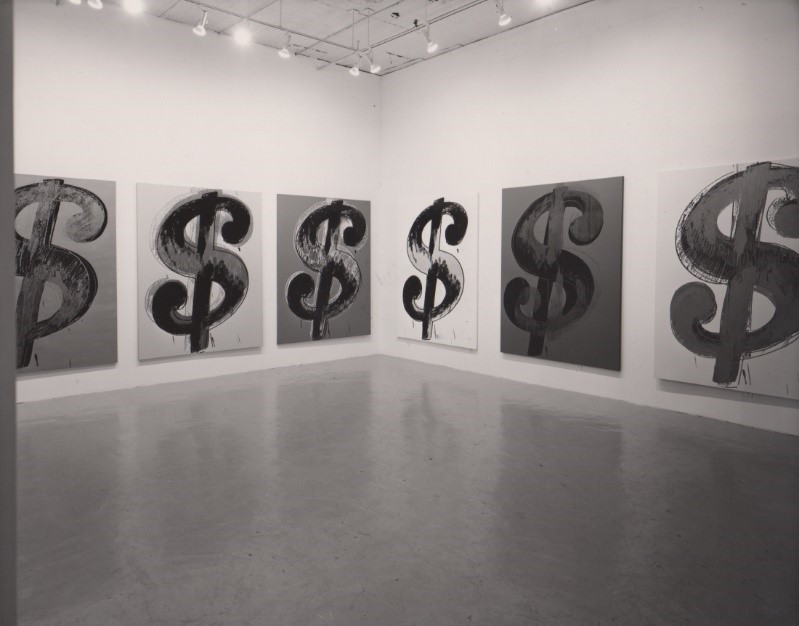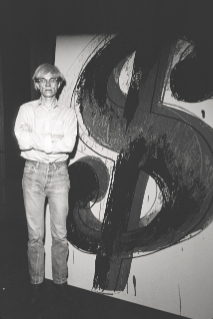“I like money on the wall. Say you were going to buy… a painting. I think you should take that money, tie it up, and hang it on the wall. Then when someone visited you, the first thing they would see is the money on the wall.”
– Andy Warhol
Andy Warhol was born in 1928 in the industrial hub of Pittsburgh, United States. Though his brothers would refer to his childhood days as ‘spoiled’, their family were poor and Warhol’s relationship with money was complicated. By the time he moved to New York however, in 1949, following his graduation from the Carnegie Institute of Technology where he studied Pictorial Design, the United States was changing rapidly as it underwent a phenomenal post-World War II economic growth. After years of wartime rationing and fuelled by innovations in technology and a vitality of commercialism, manufacturing rocketed as consumer consumption peaked at a historic high. Supplemented by visually saturated advertisements encouraging America to buy, buy, buy - it was a era of prosperity: of poodle-skirts, side-burns, credit-cards, and jukeboxes. Marilyn Monroe graced newly colourised tv screens and America jived to Elvis Presley’s Jailhouse Rock.
Both intrigued and amused by the relationship between wealth and power, Warhol began using money as a motif in his practice as early as the 1950s, predating Pop Art with his drawing of a tree sprouting abundant foliage of U.S. currency. A decade later in 1962, he returned to the theme again with silkscreened paintings of dollar bill drawings he had photographed - created in part because photographing and reprinting the bills directly would constitute counterfeit. In applying to the canvas a manufacturing technique typically associated with commercial printing, he ignited a critical revaluation of what one had come to expect of the properties of a work of art.

Whilst various anecdotal versions of the subject’s origins have appeared in Warhol literature, in his 1970 essay Raggedy Andy, Calvin Tomkin cites Warhol’s inspiration as stemming from a conversation the artist had with interior designer and gallerist Muriel Latow. As the story goes, Warhol prompted her for ‘fabulous ideas’ and in response she jokingly charged him fifty dollars. As Warhol wrote a cheque, Latow replied: ‘Money. The thing that means more to you than anything else in the world is money. You should paint pictures of money.’i
Returning to this iconography at a mature point in his remarkable career, the present work was executed the same year his Dollar Signs exhibition at the prolific Castelli Gallery on Greene Street, New York in February 1982. A month after the show, Artforum published an issue focused on artists who had ‘made it’, featuring a centrefold by Warhol whose contribution was a fold-out triptych of Dollar Sign works.

The present iteration of his instantly recognisable series is particularly alluring, composed of a painted vermillion background onto which a printed screen marks the forest-green silhouette of a dollar symbol. A second symbol is printed on top, in bill-green, and the final layer is a more-scribbled rendering of the ‘$’ but in a shade of red that draws a direct link to his Campbell's Soup works which too, are powerful in their bold reinvention of what is allowed in art.
Whilst both signature series epitomise Warhol’s fascination with commodity culture, the dollar symbol motif focuses even tighter on its essence: cash, directly subverting the historically general presumption of the bourgeois and the academic that art is above money. Indeed, in an ironically Warholian way, the ‘$’ canvas symbolically reflects his accomplishment as it has become an icon of popular culture itself and thus, a currency in its own right. And as Warhol poignantly said:
“Business art is the step that comes after art. I started as a commercial artist, and I want to finish as a business artist. Being good in business is the most fascinating kind of art. During the hippie era people put down the idea of business. They’d say “money is bad” and “working is bad”. But making money is art, and working is art - and good business is the best art.”
– Andy Warhol
And yet, given their vibrant colour and energetic drawing and design that harkens back to his early days in the illustration field, there is a strangely compelling beauty caught within the three overlapping S shapes slashed with vertical lines. As art-writer and curator Trevor Fairbrother elaborates: ‘I read the vivid brashness of these works as Warhol’s indomitable ego in full war paint. Many of these canvases organise pulsating saturated colours into a spectacle as flagrant as a marching band or the lights on Broadway. Multiple overlaid impressions of the motif, deliberately misaligned, make the dollar sign appear to quiver and strain like a fish thrashing in a net.’ii
Perhaps inspired by the expressive forms of graffiti and painting he was coming into contact with from the rising stars of the 1980s New York art scene, including Jean-Michel Basquiat and Keith Haring, Dollar Sign exudes a determined graphic aesthetic and chromatic brilliance that perfectly defines this celebrated series. In fact, as a result of his energised painterly approach, there is an underlying ‘menace [that] lurks in [the] throbs and drips’ that makes us question whether ‘by depicting the American monetary symbol in iconic splendour, did Warhol romanticise or X-ray his subject?’ iii

More than any other artist of his generation, Warhol understood how the reproduced image had come to reflect and shape our contemporary life and through combining popular culture imagery with printing processes from the commercial world, he discovered a way to be original. By the time of his death on 22 February 1987, he was one of the most well-known artists the world had ever seen, leaving behind a legacy as the founding father and defining figure of the Pop art movement that is far greater than his one prescient observation that ‘everyone will be world famous for fifteen minutes.’ Forty years on from its execution as the global economy unites into the biggest commodity trading floor mankind has ever known, the Dollar Sign is even more alive today, stimulating imagination and evoking desire as a signature for cash, for art, and ultimately, for Warhol himself.